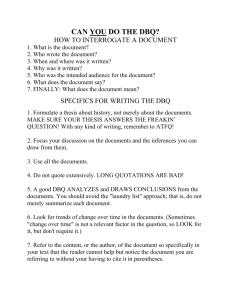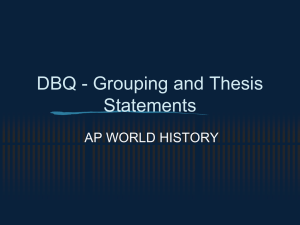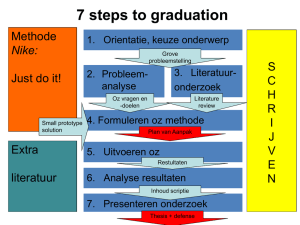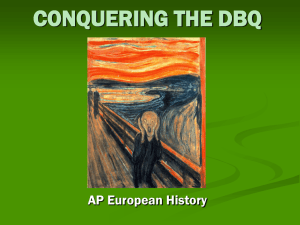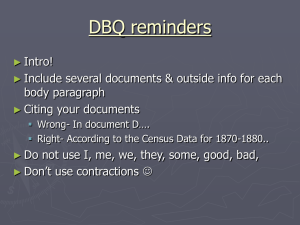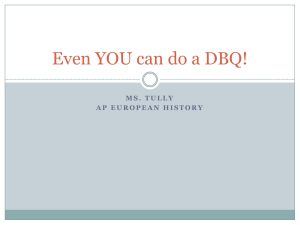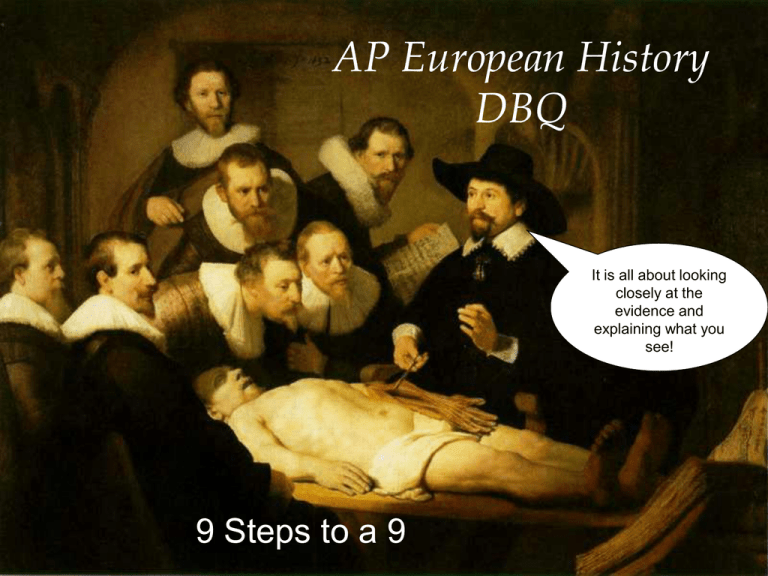
AP European History
DBQ
It is all about looking
closely at the
evidence and
explaining what you
see!
9 Steps to a 9
What is a DBQ?
• The name has it: this essay uses
documents as persuasive evidence in
your response to the question.
• If you don’t answer the question by
carefully analyzing and incorporating
the documents, you have missed the
task.
What do you need to do?
• Answer the historical question directly
• Provide a clear, complex thesis that does
not simply rephrase the question
• Outline your supporting arguments
• Use the documents persuasively as
evidence for your arguments
• Show awareness of how point-of-view
affects the information in documents
• Find themes and connections between
documents
This
sounds
impossible!
Fear not!
• DBQs are not impossible. They are
challenging but also fun.
• You get to condense all of your historical
skills into short bursts of interpretation
• The more you practice, the easier they get
• There are 9 steps to a perfect 9…
–Practice these every time and your
score will continue to improve!
Step 1: Read the Instructions
• An AP DBQ will typically provide you with
several handy pieces of information
– Timing guidelines
– Reminders (a “checklist” of skills)
• Thesis answers question
• Majority of documents specifically used
• POV and Groupings
– A question or prompt that breaks down the
tasks into several parts
– Historical background information
Step 2. Read and Interpret the
Question
• Read the question for what
is says and what it implies
• Rephrase the question for
yourself
• List the tasks individually
(describe, analyze…)
• List the parts of your
answer you will need
• Rewrite dates (17th century
1600s)
Step 3. Background to Foreground
Frame the time and
place with hub
dates—list them!
Use
“PERSIA”!
Jot down a
preliminary
thesis—how
would you
answer this
without
documents?
Step 4. Skim the Documents for
Key Information
Hey! You know this
guy! Always skim
for known authors
and documents
Document 3
Information about
nationality and
occupation of
author
Source: Jacques Bossuet, French Bishop,
Politics Taken from the Very Word of
Scripture, 1679
If the
main idea The power of God makes itself felt in a moment
is easy to
from one extremity of the earth to another.
identify
Royal power works at the same time
on first
throughout all the realm. It holds all the realm
in position, as God holds the earth. Should
glance,
God withdraw his hand, the earth would fall to
highlight
pieces; should the king's authority cease in
or note it
the realm, all would be in confusion.
Check for
years on
each
document
and keep
them
grouped
around hub
dates, and
early to late
Step 5. Mark-up the Documents,
keeping organizers as you go
• Highlight or underline
only CRITICAL info, the
summarize in margins
• Group by date, by
nationality, by topic, by
author, by type
• POV indicators:
sex/ gender, class,
occupation, religion,
political affiliation, age
Don’t waste time
summarizing each
document—just the
stuff you might use.
Create a “T-chart” or
web to establish
groups, and let the
question guide you.
Always ask: what do I
(think I) know about
the author, and how
would that influence
the perspective here?
Step 6. Analyze the documents
Sola Scriptura?… Now it is
just you and the text. So what
are the documents saying in
response to the question?
What are the documents
saying to each other?
You are responsible for helping your readers see what you
see—analysis is not just about observing, but also
describing and explaining!
Step 7. Revise and Clarify your
THESIS
A great DBQ thesis must…
Fully and directly answer the question
Go beyond restating the question
Take a stand that is debatable and
defensible
Clearly preview (outline) where you are going
with your arguments
Be based on the evidence at hand
If you can’t support it with the documents, it isn’t
a great DBQ thesis!
Step 8. Set the Stage
Give a sense of
place and
context—what
are the big
themes, and
where are we,
literally?
Get to the heart of
the matter: State
your thesis clearly,
and outline your
arguments to
come.
Set the time
clearly for
readers—what
has come
before.
What are the
issues in the
background
that frame your
thesis?
Step 9. Persuade with Evidence
and Write with Flair!
• Write your essay in an
organized, 5-P format
• Underline your thesis
• State your claims and
back them up with
sound argumentation
• Always explain your
evidence
• Write with enthusiasm
and energy!
A few follow-up points
• Remember to introduce your evidence as
you would introduce a guest…with
relevant information and thoughtful details.
“Immanuel Kant, an influential Prussian
philosopher in the time of Frederick II,
believed that a free press was a necessary
pre-condition to an Enlightened Society.”
NOT: Document 4 says there should be a free press.
Describe POV with care
• Explain WHY the
person’s identity would
influence his or her
understanding…
“Elizabeth I, who as a young
monarch struggled to control
religious dissenters, understood
the stability of the state to be
more important than personal
religious conviction. This is seen
in…”
Check Yourself!
? Did you underline your thesis?
? Did you answer all parts of the question?
? Did you outline your arguments in the
opening paragraph?
? Did you set the time and place?
? Did you describe and explain documents?
? Did you introduce your people with relevant
information?
? Did you use a majority of the documents?

